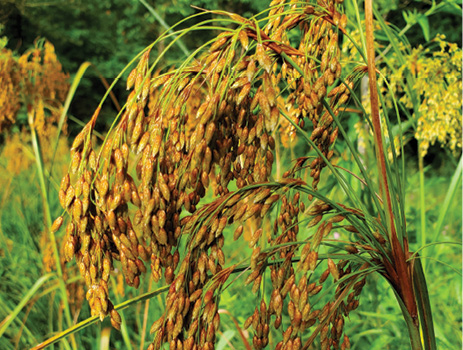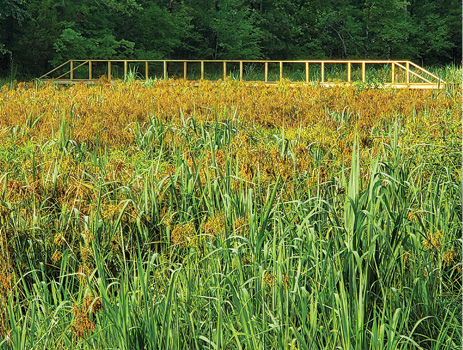Bulrush | Schoenoplectus spp.
Emergent | Native



s lower on the side of the stem.
Bulrushes are a group of common native species in the sedge family that grow in damp areas and along the shallow shorelines of ponds and wetlands up to a depth of 3 to 4 feet. Some species can grow to heights of 5 to 10 feet.
Bulrushes usually have round stems that are hollow and are thicker at the base. Most species have a loose cluster of brownish flowers at or near the tip of the stem, which bloom in late spring to summer.
Bulrushes are similar to Juncus in appearance, but Juncus is usually shorter with flowers appearing to be more on the side of the stem. Bulrush flowers are more terminal. Each flower produces one seed, which has a flat surface on one side and a convex surface on the other.
Management Value
Bulrushes are native and an important part of natural ecosystems. The seeds are consumed by ducks and other birds; several bird species nest in bulrush stands; and a variety of species, including geese and muskrats, eat the early growth and rhizomes. Bulrushes can make excellent fish habitat, with some species spawning on or among bulrush stems and roots. Bulrushes can hinder wind and wave activity, increasing sediment stabilization and slowing shoreline erosion.
Bulrushes can become problematic, and introducing them to managed ponds is not recommended. However, when present, control is only necessary when they become too abundant or hinder use of the water body.
Recommended Controls
Glyphosate (5.4-pound formulation). For each gallon of water, mix 5.1 ounces glyphosate and 1.3 ounces surfactant. Spray to wet all exposed plants. Do not exceed annual herbicide rate limits as stated on the product label.
Multiple herbicide applications are likely necessary to achieve eradication. The best approach is to treat ponds with herbicide when the plants are actively growing and water temperature is at least 60˚F.
Read and follow all chemical label instructions, especially the section on the use of personal protection equipment.

The information given here is for educational purposes only. References to commercial products, trade names, or suppliers are made with the understanding that no endorsement is implied and that no discrimination against other products or suppliers is intended.
Publication 3735-19 (POD-11-23)
By Wes Neal, PhD, Extension/Research Professor, Wildlife, Fisheries, and Aquaculture; Dennis Riecke, Fisheries Coordinator, Mississippi Department of Wildlife, Fisheries, and Parks; and Gray Turnage, PhD, Assistant Research/Extension Professor, GeoSystems Research Institute.
The Mississippi State University Extension Service is working to ensure all web content is accessible to all users. If you need assistance accessing any of our content, please email the webteam or call 662-325-2262.



